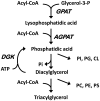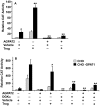Lysophosphatidic acid activates peroxisome proliferator activated receptor-γ in CHO cells that over-express glycerol 3-phosphate acyltransferase-1
- PMID: 21533082
- PMCID: PMC3080373
- DOI: 10.1371/journal.pone.0018932
Lysophosphatidic acid activates peroxisome proliferator activated receptor-γ in CHO cells that over-express glycerol 3-phosphate acyltransferase-1
Abstract
Lysophosphatidic acid (LPA) is an agonist for peroxisome proliferator activated receptor-γ (PPARγ). Although glycerol-3-phosphate acyltransferase-1 (GPAT1) esterifies glycerol-3-phosphate to form LPA, an intermediate in the de novo synthesis of glycerolipids, it has been assumed that LPA synthesized by this route does not have a signaling role. The availability of Chinese Hamster Ovary (CHO) cells that stably overexpress GPAT1, allowed us to analyze PPARγ activation in the presence of LPA produced as an intracellular intermediate. LPA levels in CHO-GPAT1 cells were 6-fold higher than in wild-type CHO cells, and the mRNA abundance of CD36, a PPARγ target, was 2-fold higher. Transactivation assays showed that PPARγ activity was higher in the cells that overexpressed GPAT1. PPARγ activity was enhanced further in CHO-GPAT1 cells treated with the PPARγ ligand troglitazone. Extracellular LPA, phosphatidic acid (PA) or a membrane-permeable diacylglycerol had no effect, showing that PPARγ had been activated by LPA generated intracellularly. Transient transfection of a vector expressing 1-acylglycerol-3-phosphate acyltransferase-2, which converts endogenous LPA to PA, markedly reduced PPARγ activity, as did over-expressing diacylglycerol kinase, which converts DAG to PA, indicating that PA could be a potent inhibitor of PPARγ. These data suggest that LPA synthesized via the glycerol-3-phosphate pathway can activate PPARγ and that intermediates of de novo glycerolipid synthesis regulate gene expression.
Conflict of interest statement
Figures





Similar articles
-
Identification of an intracellular receptor for lysophosphatidic acid (LPA): LPA is a transcellular PPARgamma agonist.Proc Natl Acad Sci U S A. 2003 Jan 7;100(1):131-6. doi: 10.1073/pnas.0135855100. Epub 2002 Dec 26. Proc Natl Acad Sci U S A. 2003. PMID: 12502787 Free PMC article.
-
Lysophosphatidic acid inhibits adipocyte differentiation via lysophosphatidic acid 1 receptor-dependent down-regulation of peroxisome proliferator-activated receptor gamma2.J Biol Chem. 2005 Apr 15;280(15):14656-62. doi: 10.1074/jbc.M412585200. Epub 2005 Feb 14. J Biol Chem. 2005. PMID: 15710620
-
Glycerolipid signals alter mTOR complex 2 (mTORC2) to diminish insulin signaling.Proc Natl Acad Sci U S A. 2012 Jan 31;109(5):1667-72. doi: 10.1073/pnas.1110730109. Epub 2012 Jan 17. Proc Natl Acad Sci U S A. 2012. PMID: 22307628 Free PMC article.
-
Transcriptional Regulation of Acyl-CoA:Glycerol-sn-3-Phosphate Acyltransferases.Int J Mol Sci. 2019 Feb 22;20(4):964. doi: 10.3390/ijms20040964. Int J Mol Sci. 2019. PMID: 30813330 Free PMC article. Review.
-
Regulation of Triglyceride Metabolism. II. Function of mitochondrial GPAT1 in the regulation of triacylglycerol biosynthesis and insulin action.Am J Physiol Gastrointest Liver Physiol. 2007 May;292(5):G1195-9. doi: 10.1152/ajpgi.00553.2006. Epub 2006 Dec 7. Am J Physiol Gastrointest Liver Physiol. 2007. PMID: 17158253 Free PMC article. Review.
Cited by
-
Dietary lysophosphatidylcholine regulates diacylglycerol, cardiolipin and free fatty acid contents in the fillet of turbot.Food Chem X. 2022 Mar 24;14:100293. doi: 10.1016/j.fochx.2022.100293. eCollection 2022 Jun 30. Food Chem X. 2022. PMID: 35356697 Free PMC article.
-
Human GDPD3 overexpression promotes liver steatosis by increasing lysophosphatidic acid production and fatty acid uptake.J Lipid Res. 2020 Jul;61(7):1075-1086. doi: 10.1194/jlr.RA120000760. Epub 2020 May 19. J Lipid Res. 2020. PMID: 32430316 Free PMC article.
-
GPAT1 Activity and Abundant Palmitic Acid Impair Insulin Suppression of Hepatic Glucose Production in Primary Mouse Hepatocytes.J Nutr. 2024 Apr;154(4):1109-1118. doi: 10.1016/j.tjnut.2024.02.004. Epub 2024 Feb 13. J Nutr. 2024. PMID: 38354952 Free PMC article.
-
Bioactive oxidatively truncated phospholipids in inflammation and apoptosis: formation, targets, and inactivation.Biochim Biophys Acta. 2012 Oct;1818(10):2456-64. doi: 10.1016/j.bbamem.2012.03.004. Epub 2012 Mar 16. Biochim Biophys Acta. 2012. PMID: 22445850 Free PMC article. Review.
-
Lipin-1 phosphatidic phosphatase activity modulates phosphatidate levels to promote peroxisome proliferator-activated receptor γ (PPARγ) gene expression during adipogenesis.J Biol Chem. 2012 Jan 27;287(5):3485-94. doi: 10.1074/jbc.M111.296681. Epub 2011 Dec 6. J Biol Chem. 2012. PMID: 22157014 Free PMC article.
References
-
- Gervois P, Fruchart J-C, Staels B. Inflammation, dyslipidaemia, diabetes and PPARs: pharmacological interest of dual PPARa and PPARg agonists. Int J Clin Pract. 2004;58:22–29. - PubMed
-
- Berger J, Moller DE. The mechanisms of action of PPARs. Annu Rev Med. 2002;53:409–435. - PubMed
-
- Moolenaar WH, van Meeteren LA, Giepmans BN. The ins and outs of lysophosphatidic acid signaling. Bioessays. 2004;26:870–881. - PubMed
-
- Tsukahara T, Tsukahara R, Yasuda S, Makarova N, Valentine WJ, et al. Different residues mediate recognition of 1-O-oleyl-lysophosphatidic acid and rosiglitazone in the ligand binding domain of PPARg. J Biol Chem. 2006;281:3398–3407. - PubMed
Publication types
MeSH terms
Substances
Grants and funding
- P30 ES010126/ES/NIEHS NIH HHS/United States
- DK59935/DK/NIDDK NIH HHS/United States
- DK68993/DK/NIDDK NIH HHS/United States
- F32 DK068993/DK/NIDDK NIH HHS/United States
- HHMI/Howard Hughes Medical Institute/United States
- U24 DK059635/DK/NIDDK NIH HHS/United States
- R01 DK040936/DK/NIDDK NIH HHS/United States
- R01 DK059935/DK/NIDDK NIH HHS/United States
- U24 DK59635/DK/NIDDK NIH HHS/United States
- P30 DK034987/DK/NIDDK NIH HHS/United States
- R56 DK056598/DK/NIDDK NIH HHS/United States
- R01 DK056598/DK/NIDDK NIH HHS/United States
- P30 DK045735/DK/NIDDK NIH HHS/United States
- DK40936/DK/NIDDK NIH HHS/United States
- DK56598/DK/NIDDK NIH HHS/United States
- P30 DK34987/DK/NIDDK NIH HHS/United States
LinkOut - more resources
Full Text Sources
Miscellaneous

